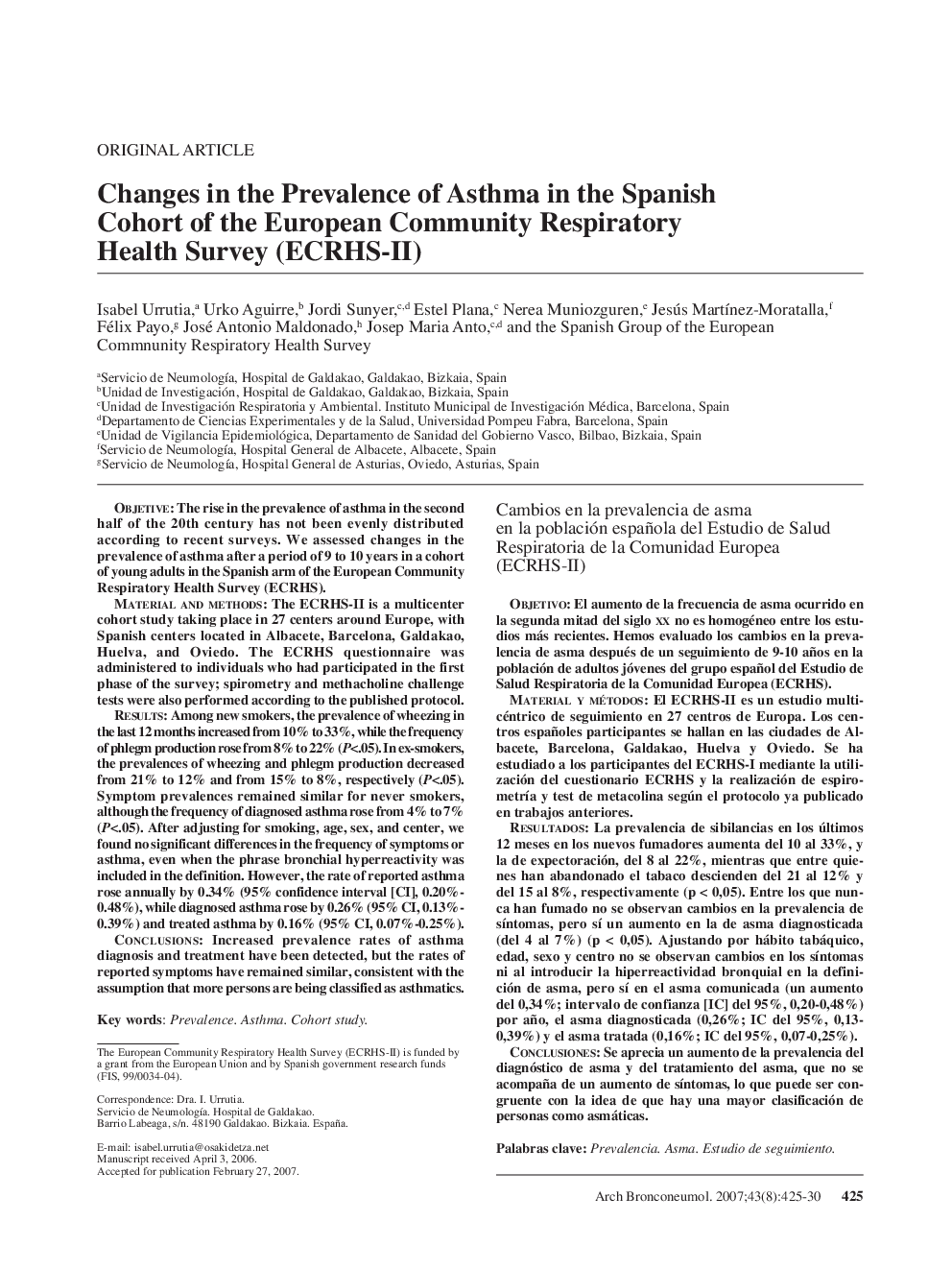| Article ID | Journal | Published Year | Pages | File Type |
|---|---|---|---|---|
| 4206267 | Archivos de Bronconeumología (English Edition) | 2007 | 6 Pages |
ObjetiveThe rise in the prevalence of asthma in the second half of the 20th century has not been evenly distributed according to recent surveys. We assessed changes in the prevalence of asthma after a period of 9 to 10 years in a cohort of young adults in the Spanish arm of the European Community Respiratory Health Survey (ECRHS).Material and MethodsThe ECRHS-II is a multicenter cohort study taking place in 27 centers around Europe, with Spanish centers located in Albacete, Barcelona, Galdakao, Huelva, and Oviedo. The ECRHS questionnaire was administered to individuals who had participated in the first phase of the survey; spirometry and methacholine challenge tests were also performed according to the published protocol.ResultsAmong new smokers, the prevalence of wheezing in the last 12 months increased from 10% to 33%, while the frequency of phlegm production rose from 8% to 22% (P <.05). In ex-smokers, the prevalences of wheezing and phlegm production decreased from 21% to 12% and from 15% to 8%, respectively (P <.05). Symptom prevalences remained similar for never smokers, although the frequency of diagnosed asthma rose from 4% to 7% (P <.05). After adjusting for smoking, age, sex, and center, we found no significant differences in the frequency of symptoms or asthma, even when the phrase bronchial hyperreactivity was included in the definition. However, the rate of reported asthma rose annually by 0.34% (95% confidence interval [CI], 0.20%-0.48%), while diagnosed asthma rose by 0.26% (95% CI, 0.13%-0.39%) and treated asthma by 0.16% (95% CI, 0.07%-0.25%).ConclusionsIncreased prevalence rates of asthma diagnosis and treatment have been detected, but the rates of reported symptoms have remained similar, consistent with the assumption that more persons are being classified as asthmatics.
ObjetivoEl aumento de la frecuencia de asma ocurrido en la segunda mitad del siglo XX no es homogéneo entre los estudios más recientes. Hemos evaluado los cambios en la prevalencia de asma después de un seguimiento de 9-10 años en la población de adultos jóvenes del grupo español del Estudio de Salud Respiratoria de la Comunidad Europea (ECRHS).Material Y MÉtodosEl ECRHS-II es un estudio multi- céntrico de seguimiento en 27 centros de Europa. Los centros españoles participantes se hallan en las ciudades de Albacete, Barcelona, Galdakao, Huelva y Oviedo. Se ha estudiado a los participantes del ECRHS-I mediante la utilización del cuestionario ECRHS y la realización de espirometría y test de metacolina según el protocolo ya publicado en trabajos anteriores.ResultadosLa prevalencia de sibilancias en los últimos 12 meses en los nuevos fumadores aumenta del 10 al 33%, y la de expectoración, del 8 al 22%, mientras que entre quienes han abandonado el tabaco descienden del 21 al 12% y del 15 al 8%, respectivamente (p < 0,05). Entre los que nunca han fumado no se observan cambios en la prevalencia de síntomas, pero sí un aumento en la de asma diagnosticada (del 4 al 7%) (p < 0,05). Ajustando por hábito tabáquico, edad, sexo y centro no se observan cambios en los síntomas ni al introducir la hiperreactividad bronquial en la definición de asma, pero sí en el asma comunicada (un aumento del 0,34%; intervalo de confianza [IC] del 95%, 0,20-0,48%) por año, el asma diagnosticada (0,26%; IC del 95%, 0,13- 0,39%) y el asma tratada (0,16%; IC del 95%, 0,07-0,25%).ConclusionesSe aprecia un aumento de la prevalencia del diagnóstico de asma y del tratamiento del asma, que no se acompaña de un aumento de síntomas, lo que puede ser congruente con la idea de que hay una mayor clasificación de personas como asmáticas.
